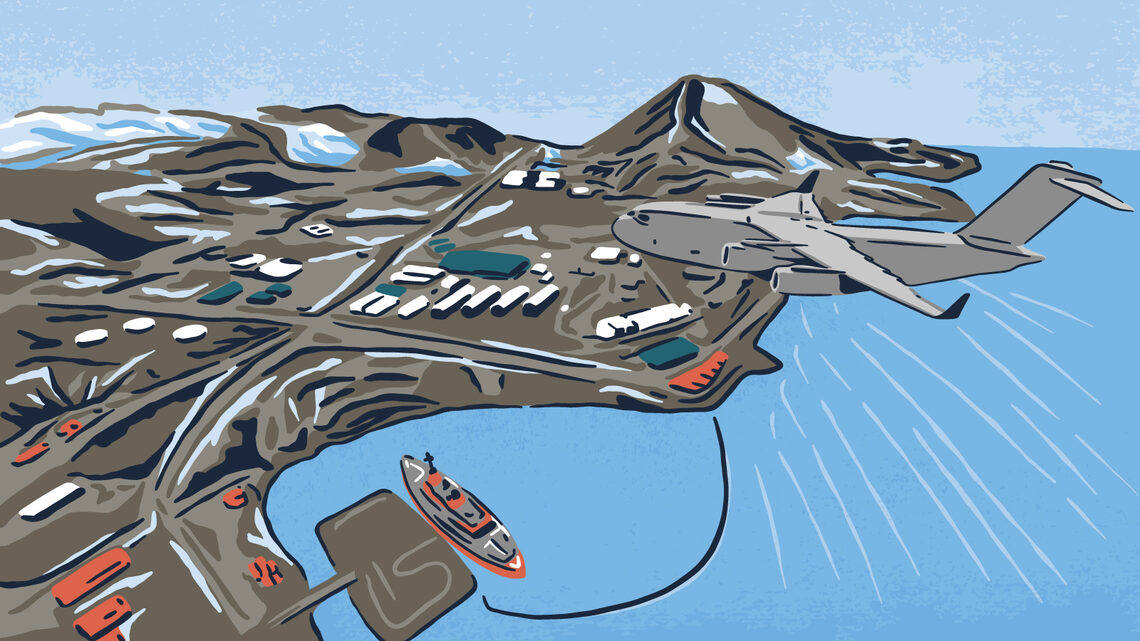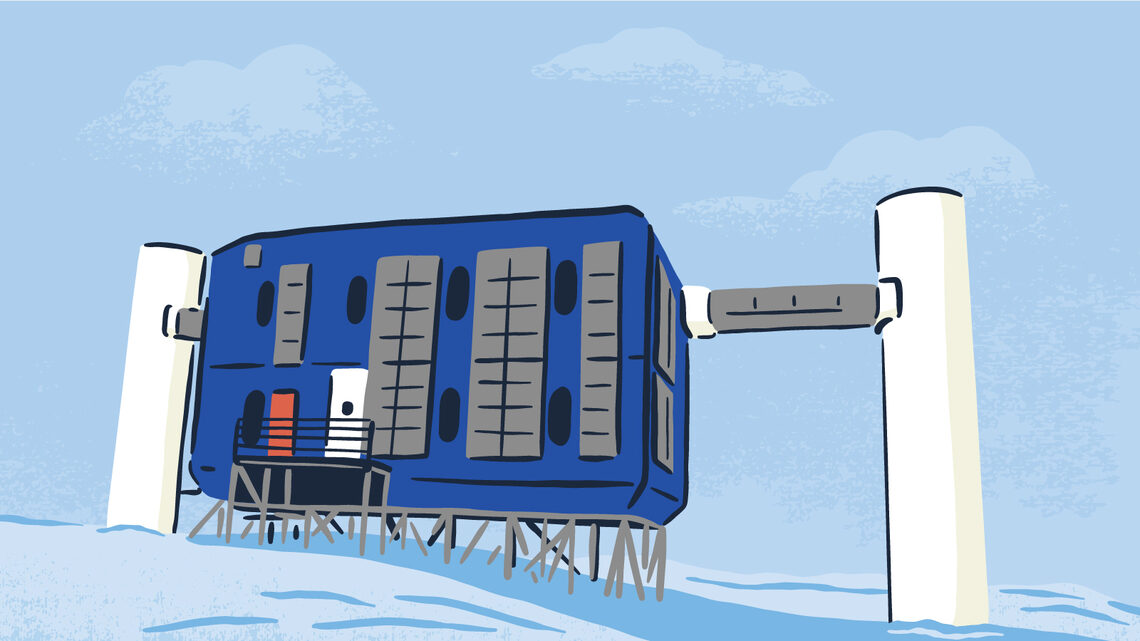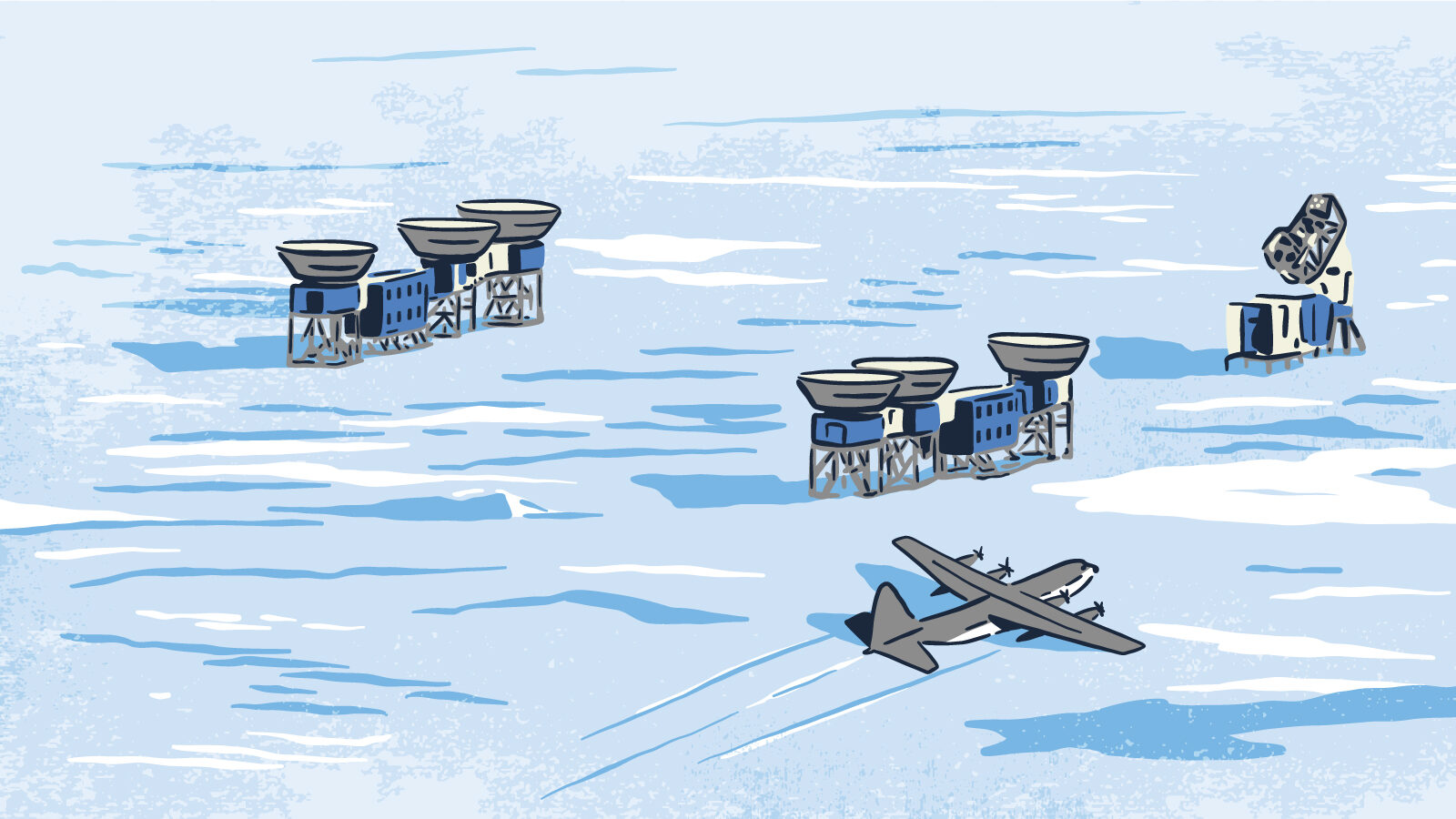About once every year or two, physicist Albrecht Karle faces a five-day commute. And that timeline is only if everything goes perfectly.
The University of Wisconsin–Madison professor is a co-leader of operations for the IceCube Neutrino Observatory, a massive physics experiment at the South Pole funded by the US National Science Foundation and partners. And while, yes, Karle gets most of his work done at the offices of UW’s Wisconsin IceCube Particle Astrophysics Center in Madison, he does occasionally need to get to the Pole.
The first steps on his journey are a series of commercial flights from Madison to Los Angeles to Auckland, New Zealand, and on to Christchurch. Ideally, this takes 30 hours over two calendar days. Karle stays a couple of nights in Christchurch, home of the US Antarctic Program deployment hub, to pick up extreme cold-weather gear—parkas, gloves, hats, etc.—and do any check-in procedures with USAP.
Karle’s next stop is McMurdo Station, an international research facility run by NSF on the coast of Antarctica, and USAP’s logistics headquarters. Depending on which military transport plane he takes—a Boeing C-17 or a Lockheed LC-130—it could take four or seven hours, respectively.
At McMurdo, Karle must wait for the weather to permit the final leg of the trip. “It is not uncommon to spend several days in McMurdo,” he says. (Karle’s record is 10.) When it’s time, he takes a 3.5-hour flight on a ski-equipped LC-130 aircraft to reach the South Pole. Anyone or anything else that goes to the South Pole must take a similarly tedious route.
There’s a reason scientists have endured the challenges of the climate, the commute and the cost for over half a century—since members of the US Navy completed the original Amundsen–Scott South Pole Station in 1957. Despite all the trouble it takes to get there, the South Pole is an unparalleled environment for scientific research, from climate science and glaciology to particle physics and astrophysics.
This sentiment was echoed by the Particle Physics Project Prioritization Panel in its 2023 report, a decadal plan for the future of particle physics research in the United States. Under its recommendation to “Construct a portfolio of major projects that collectively study nearly all fundamental constituents of our universe and their interactions,” the report prioritized support for five specific projects—two of which are located at the South Pole: cosmic microwave background experiment CMB-S4, the top priority, and neutrino experiment IceCube-Gen2, recommended fifth. Because of the high scientific priority of these projects, the report also urged maintenance of the South Pole site.
So what makes the South Pole an ideal destination for physics? And what will it take to keep it that way?

The only ones unwise enough to stay
The sole research station at the South Pole is the Amundsen–Scott South Pole Station. Since it was completed, the station has undergone several expansions and upgrades. NSF, which now administers all activities at the South Pole through its Office of Polar Programs, built the current iteration of the station in the early 2000s, completing it in 2008.
Most of the physical labor at the South Pole is done during the summer season when it’s “warm” enough for people to work outside; the average summer temperature is minus 15 degrees Fahrenheit (minus 26 degrees Celsius). The sun begins to rise on the equinox in September, kicking off six months of uninterrupted sunlight and the singular “day” of the year. When the summer season begins in November, scientists fly in from around the world—taking routes that parallel Karle’s—to perform maintenance, conduct experiments and prepare the Pole for the winter.
By February 15, most individuals have returned home, with the exception of about 40 “winterovers.” The intrepid skeleton crew lives in the South Pole Station from February to November, spanning the Pole’s only “night,” ensuring the experiments run properly and performing any necessary troubleshooting. During this winter season, the temperature averages minus 76 degrees Fahrenheit (minus 60 degrees Celsius).
At the heart of the continent, the South Pole receives almost no precipitation, and the air humidity is near zero. The only plants and animals that are native to Antarctica live close to the coast. A common joke among South Pole scientists is that humans are the only animals unwise enough to try to live in the center.
Experiments on ice
To the scientists on CMB-S4, which is designed to study the cosmic microwave background, and the IceCube experiment, which studies neutrinos, the harsh atmosphere is basically perfect. “We consider these projects as essential to understanding fundamental questions about the universe,” says Karsten Heeger, chair of the physics department at Yale University and deputy chair of P5.
Since the 1980s, the South Pole has been a hub for experiments that study the cosmic microwave background. Today, CMB research thrives at the Pole, with projects like the South Pole Telescope and the BICEP Array. In the last few years, these experiments have established the latest constraints on cosmic inflation, tested the most popular dark matter model and demonstrated a technique called “delensing” that will be crucial for the proposed CMB-S4.
Short for Cosmic Microwave Background Stage IV, CMB-S4 has science goals that include measuring the number of light relic particle species and measuring dark matter and dark energy. Importantly, members of the CMB-S4 collaboration also aim to measure a signature of cosmic inflation in the early universe from gravitational waves, which would teach them about the physics of very early universe.
“It’s kind of mind-boggling when you think about it,” says Abby Vieregg, a University of Chicago professor and member of the P5 panel who was heavily involved in formulating CMB-S4. “What we’re trying to do is build a telescope that uses light from 400,000 years after the Big Bang to look back even farther in time—at a tiny fraction of a second after the Big Bang.”
CMB-S4 would consist of an array of small- and large-aperture telescopes spread across two locations. At the South Pole site, researchers hope to install nine small-aperture telescopes 0.5 meters in diameter and one 5-meter large-aperture telescope to conduct an ultra-deep survey of 3% of the sky. These would be complemented by two 6-meter large-aperture telescopes in the Atacama Desert in Chile, also the site of a vibrant array of CMB experiments.
CMB-S4 is designed to have enough sensitivity to rule out or confirm various models of inflation.
The South Pole is ideal for this research because it is high and dry: There is a relatively thin atmosphere at its elevation of 10,000 feet, so scientists can make millimeter-wavelength observations without interference from water vapor. In addition, the South Pole doesn’t suffer daily instabilities from sunrise and sunset.
“Observations at the South Pole have really led the way and been world-leading in this area for a long time, particularly on the signature from inflation,” says Vieregg. “The exquisite control of systematics that you need to make this extremely precise measurement is possible at the South Pole, and that’s why we need to go there.”
Already at the Pole, the IceCube Neutrino Observatory operates on the principle that high-energy neutrinos will, in rare cases, undergo a collision with nuclei of atoms in the matter they pass through, which results in the creation of energetic particles. When that happens in a transparent medium like ice or water, these particles produce a tiny flash of visible light. With highly sensitive detectors and a big enough quantity of clear ice, physicists can see signals from neutrinos from outer space, suspected to have been produced by some of the most violent phenomena in the cosmos.
That’s why, from 2004 to 2011, the IceCube collaboration instrumented a cubic kilometer of South Pole ice with over 5,000 light-detecting modules. And in the 13 years since it turned on, IceCube has proven its value. For example, the collaboration has used IceCube data to find evidence of a blazar as a source of high-energy astrophysical neutrinos and, most recently, to make the first-ever neutrino map of our galaxy.
This past Antarctic summer, the IceCube collaboration began field work for the IceCube Upgrade. Karle is principal investigator of the upgrade, which will install over 700 more-powerful sensors in the center of the IceCube array in the 2025–26 Antarctic summer.
Once the upgrade is complete, the collaboration hopes to begin work on IceCube-Gen2, the proposed expansion of IceCube recommended by P5. The expansion would improve IceCube’s ability to study neutrinos and their sources.
IceCube-Gen2 would scale up the original experiment by almost a factor of 10—and at approximately the same cost as the first-generation IceCube array. Their sensors would quadruple the sensitivity of and use less power than current IceCube modules.
Uniquely, the proposed home of CMB-S4 and IceCube-Gen2 is a site, designated for science, over which the United States has sole administration.
As outlined in the Antarctic Treaty, originally signed by 12 countries in 1959, the continent of Antarctica is preserved for research, the results of which must be shared globally. Today, 56 countries are signatories of the Antarctic Treaty, and there are 90 active research stations on the continent run by over 30 countries. However, the US is the only country that administers the South Pole research station, and this has helped enable US leadership in particle physics.
The members of the P5 panel “tried to think about, ‘Where are we leading? Where do we have leadership roles, and how can we take that into the next decade and beyond?’” says Heeger. “No one else has that kind of access to the South Pole as the US.
“We see [the South Pole experiments] as really leveraging one of the unique facilities that the US has, and it puts the US in a leadership position to pursue science that cannot be pursued somewhere else or by someone else.”

Population, cargo and power
The main challenges with doing anything at the South Pole, as Karle sees it, are population, cargo and power. To construct CMB-S4 and IceCube-Gen2, scientists must work around these limitations.
First, the South Pole Station is equipped to house about 150 people, and most beds are already filled during a typical summer season.
Second, there are only two ways to get anything—humans, food, equipment, fuel, etc.—from McMurdo Station to the South Pole: airplanes and overland traverses, convoys of tractors that pull large sleds. NSF OPP typically sends 50 to 70 LC-130 flights and three traverses each summer. (Travel during winter is dangerous and therefore reserved only for emergencies.)
Finally, the South Pole has one power plant that produces 600 to 700 kilowatts of power, most of which is already allocated for use.
Scientists are working to optimize their designs and, in some cases, propose solutions to all these problems for CMB-S4 and IceCube-Gen2 construction.
For example, approximately 100 additional people—40 for CMB-S4 and 60 for IceCube-Gen2—will need to come to the South Pole during each summer of construction. Although the South Pole Station is already at capacity during a normal summer, the collaborations believe that temporary housing could be set up to host additional scientists, engineers and construction workers, as has been done at the South Pole in the past. Of course, setting up that housing would require more power, fuel, logistical resources, transportation, support staff and more.
To transport cargo, both collaborations plan to primarily use overland traverses. USAP typically sends three traverses per summer, but Karle believes they can be scaled up. Large projects like CMB-S4 and IceCube can pay for more tractors, sleds, drivers and personnel at the McMurdo and South Pole stations to enable all the traverses they will need to transport cargo, although they must still contend with the hard time constraints of the summer season.
For any remaining cargo, CMB-S4 should need about seven flights per season over three years, and IceCube-Gen2 should need three to seven flights per season over 10 years.
Once operating at full capacity, CMB-S4 and IceCube-Gen2 will require 170 and 110 kilowatts of power per year, respectively. CMB-S4 plans to transition 140 kilowatts of power from existing CMB experiments when the new telescopes come online, and it will take about four years of construction for IceCube-Gen2’s required power to exceed what is readily available at the station.
Still, the South Pole will soon need more power, and building a new generator there will be difficult. That’s why CMB-S4 and IceCube scientists are looking at a recent study from Argonne National Laboratory and the National Renewable Energy Laboratory that explored the feasibility of using solar panels, wind turbines and other renewable energy to power the Pole. “We believe there are technical solutions—either all renewable or basically upgrade the generator or a combination of both,” says Karle.
A challenging road ahead
To do any of their proposed work at the South Pole, the CMB-S4 and IceCube-Gen2 collaborations must work with NSF’s Office of Polar Programs and the USAP. NSF OPP, which oversees science at both the polar regions, wants to be sure they can maintain current buildings and facilities at the South Pole.
“Before we can consider acting on any recommendations for future research at the South Pole, we must have confidence that the South Pole infrastructure will be able to support the projects on the needed timescale,” wrote an NSF representative via email. “This is why infrastructure refurbishment is so important right now.
“As an agency dedicated to promoting the progress of science, we too have an interest in ensuring the US has the tools required to continue pushing the frontiers of science. We are committed to continuing to work with these and other projects to develop logistically supportable plans.”
In the meantime, both the CMB-S4 and IceCube-Gen2 collaborations have plenty of building, testing and development to do “up north.”
In June 2023, the US Antarctic Program began work on the “South Pole Station Master Plan,” which will “inform investments planned under the Antarctic Infrastructure Recapitalization program and ensure that the future state will achieve USAP’s mission and priorities,” USAP said in a statement.
Any future research at the South Pole will have to fit into the forthcoming plan. “We are working to ensure the involvement of our partners and of the affected research communities in these processes, with full transparency,” wrote the NSF representative.
The path forward for research at the South Pole is neither certain nor easy. But, as the physicists who work there know, nothing at the South Pole ever is.







